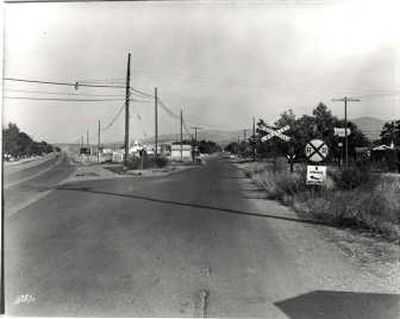Gateway to the Valley

The section of Appleway east of Barker Road is torn up now, its pockmarked surface that jolted cars being replaced by new concrete and asphalt. But the road can be forgiven for showing its age – it was 89 years old.
A piece of the road engraved with the date 10-9-19 now sits inside the Spokane Valley Heritage Museum, rescued from the trash heap. That section of road, along with Sprague Avenue, was called U.S. Highway 10 when it was built. The highway began in Detroit and ended in Seattle, roughly parallel to Interstate 90.
“It was part of our nation’s early highway system,” said museum Director Jayne Singleton. The highway brought tourism to Spokane Valley, with hotels, gas stations and tourist attractions springing up. “It spurred economic development,” she said. “You needed a place to sleep. You had to stop for gas.”
The chunk of concrete, studded with small rocks to make it stronger, has held together well. The piece weighs about 60 pounds and is 19 inches long, 8 inches wide and 6 inches high. It was cut from the southern edge of the eastbound lanes.
The numbers, worn by time, have been outlined in blue to make them easier to see. “The surface was very rough, but it’s still solid,” Singleton said. “It was certainly built to last. They don’t make them like that anymore. Everything had more character back in that time period.”
Dates were engraved on the roadway every 1/10 of a mile on the small section of original highway that remained. They were discovered by accident by volunteers who go out in the community to photograph historical features. “I had no idea how old that section of road was,” Singleton said. “When I saw the date I was amazed.”
Knowing that the road was scheduled for destruction, Singleton asked city of Spokane Valley representatives if she could remove one of the dates. They did even better. “The city wrote it into the contractor’s contract,” she said. The city presented the section of roadway to the museum this week.
Singleton is grateful that the professionally removed piece has been added to the museum’s collection. “This was important to preserve.”